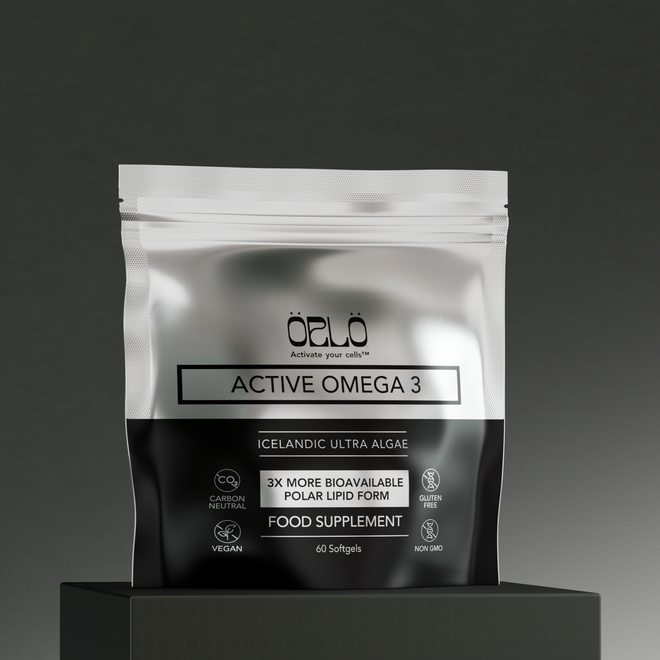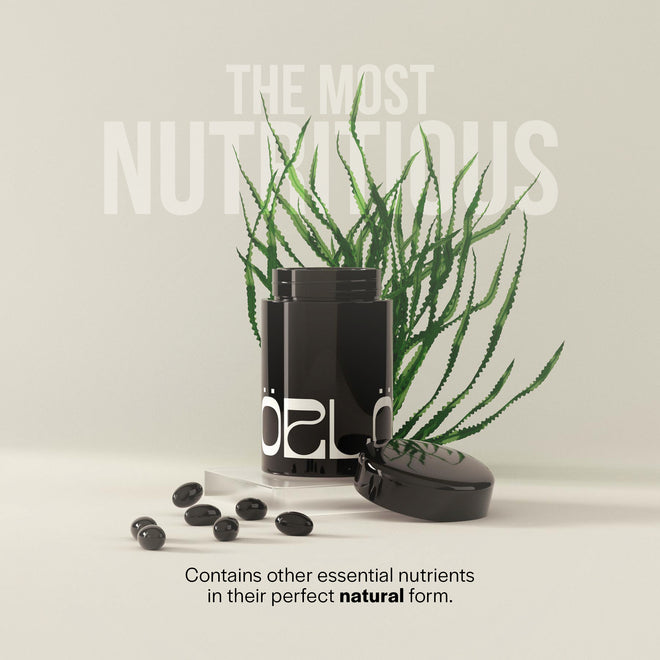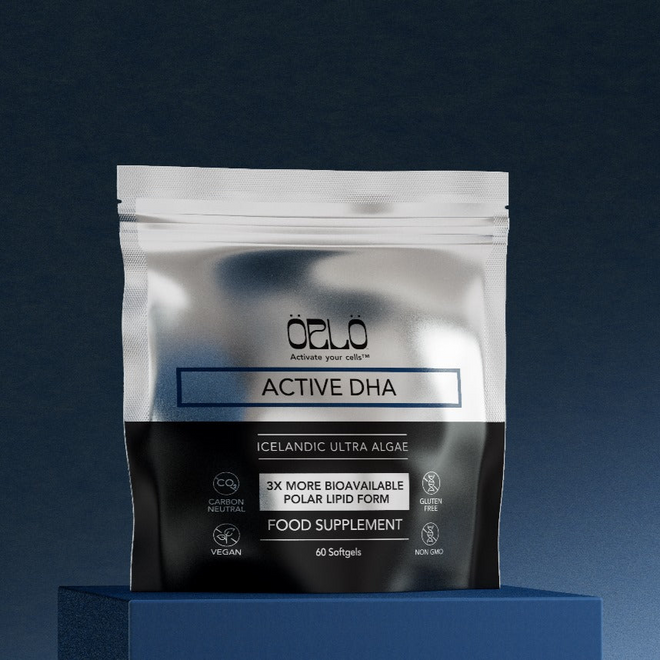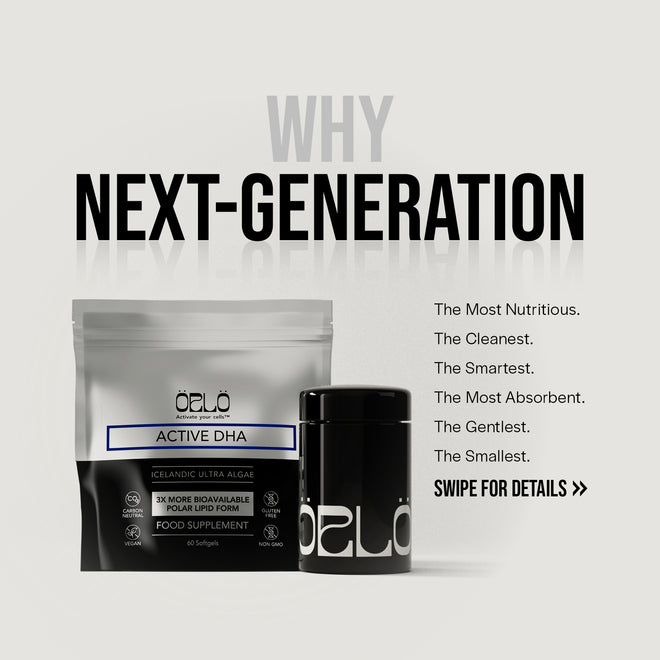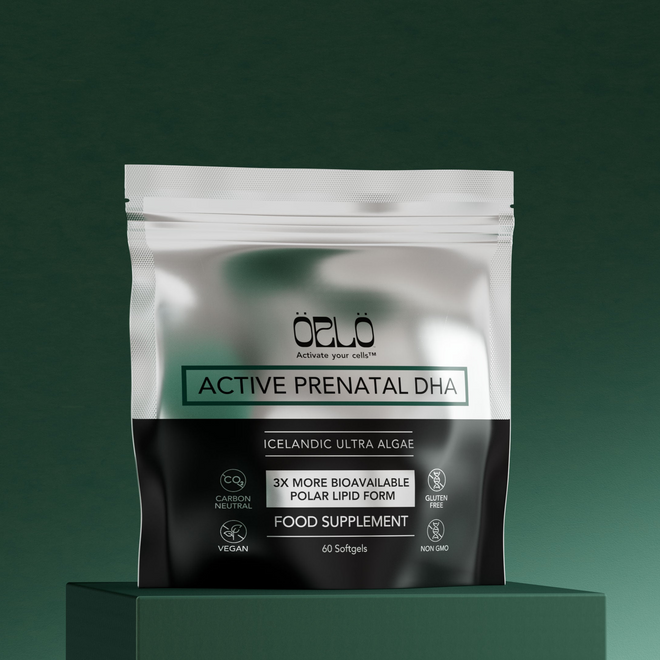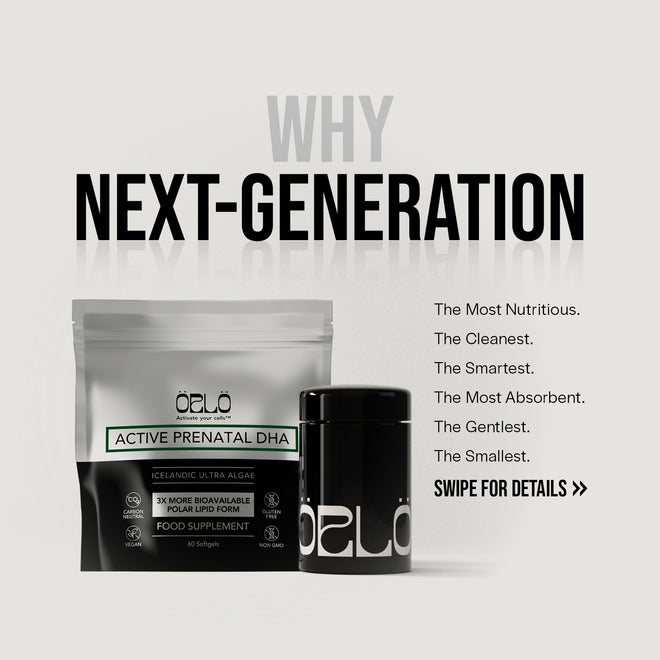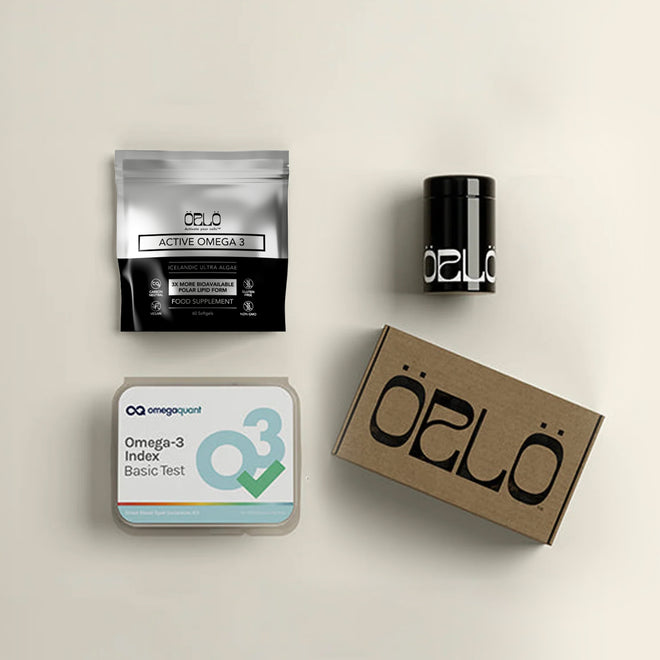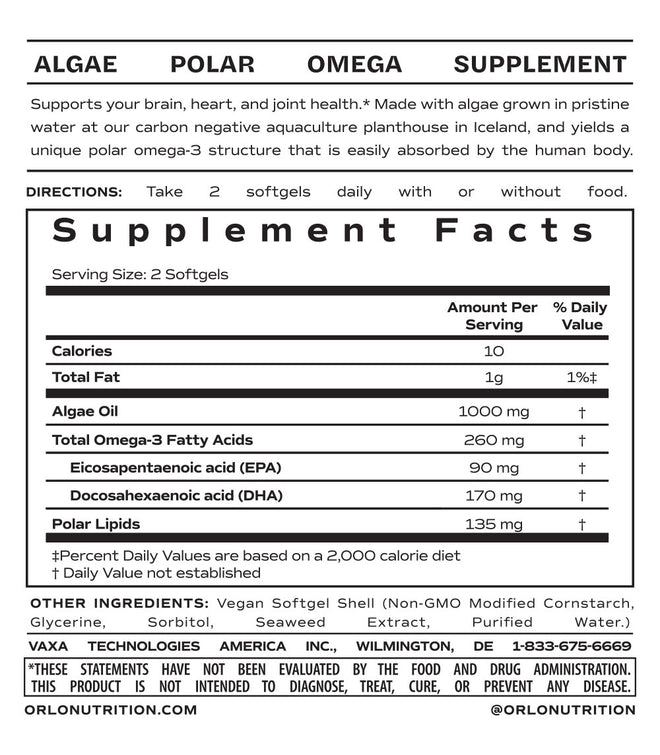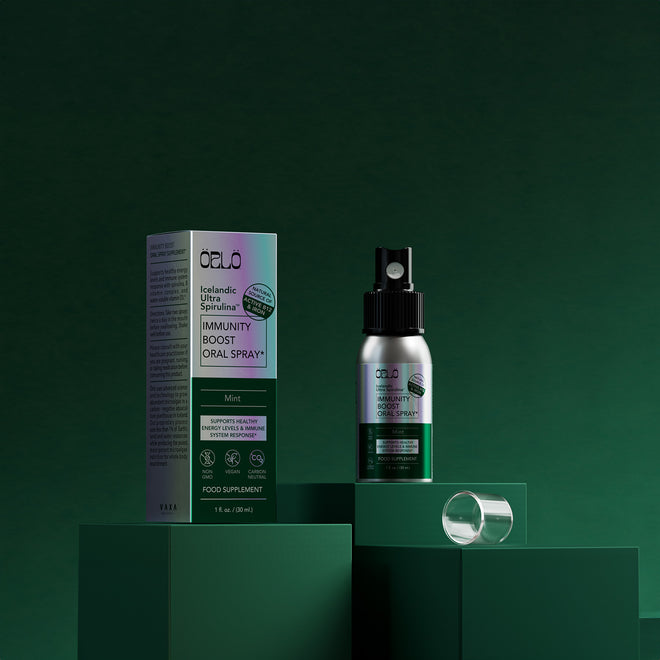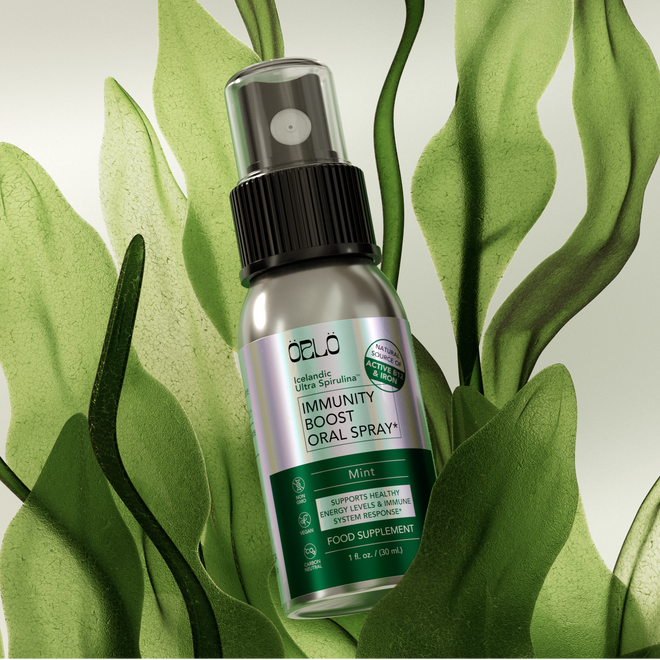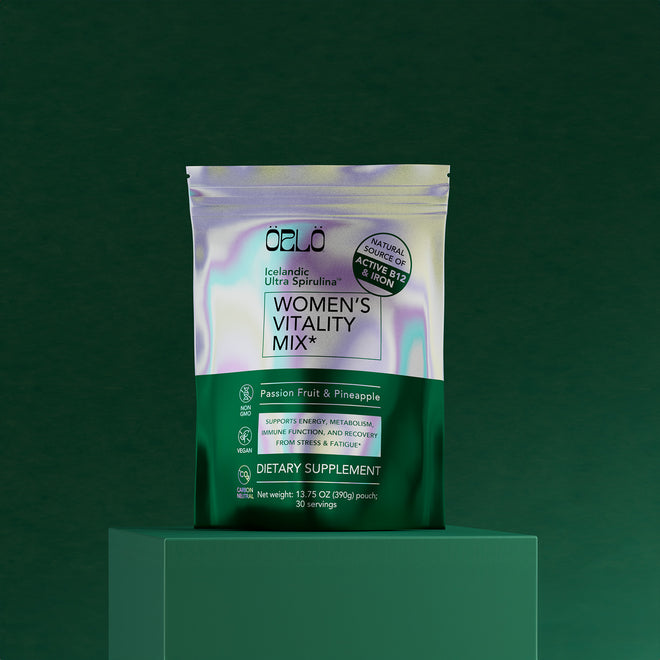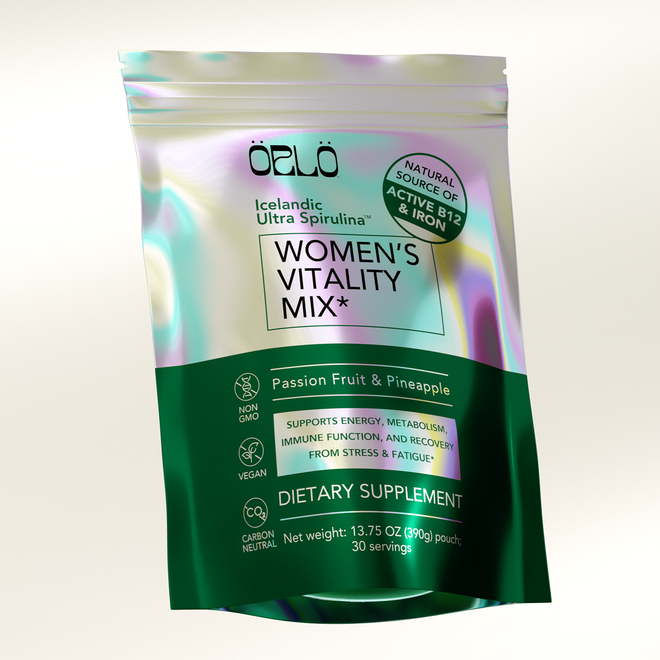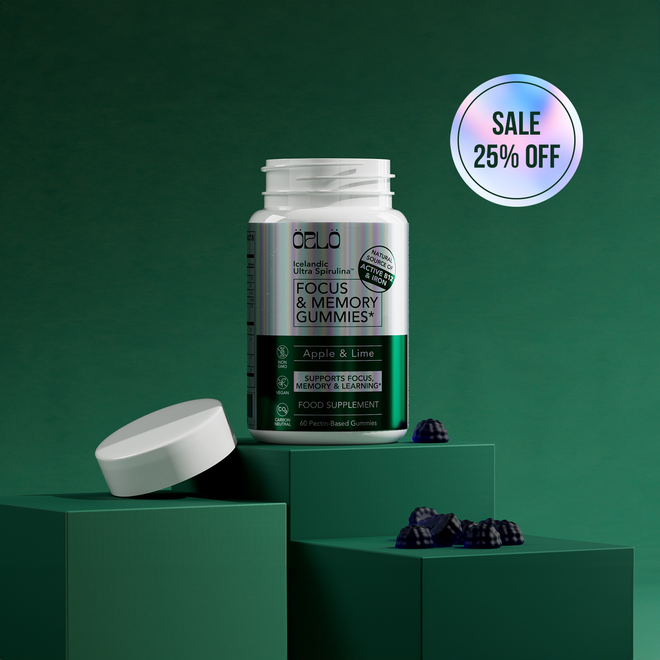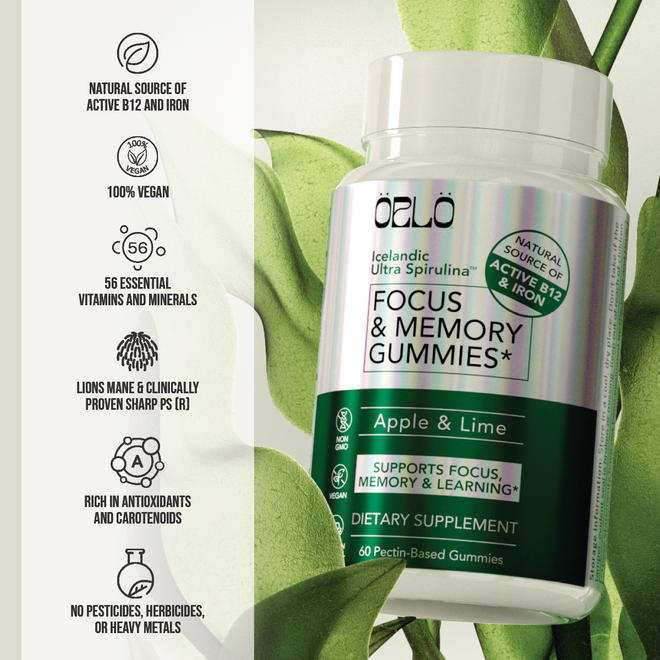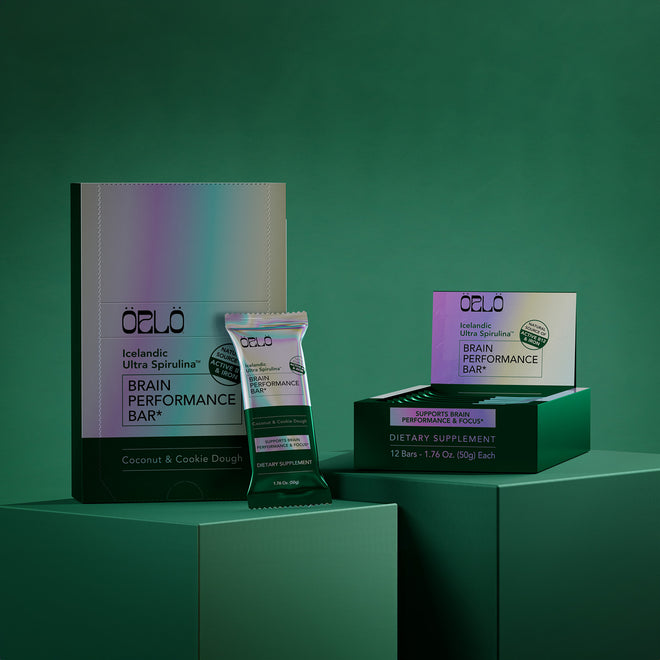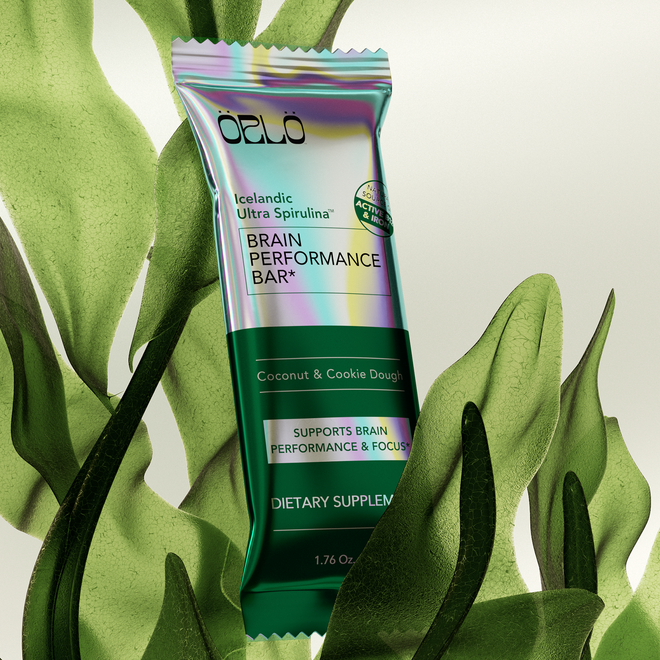25% Off - use code: HOLIDAYS
Omega-3 Health Benefits | Why These Essential Fats Matter & Finding The Best One For You
In this episode, Corinna Bellizzi, an omega-3 expert, breaks down everything you need to know about omega-3s, their benefits, and the best sources to get them. Learn how omega-3s impact your health, why the source matters, and why algae-based omega-3s are the future of nutrition and sustainability.
📌 Chapters & Timestamps
00:00 Intro & Welcome – Meet Corinna Bellizzi and what we’ll cover today.
01:00 What Are Omega-3s & Why Are They Essential? – The basics of omega-3 fatty acids (EPA & DHA) and their critical role in health.
02:30 The Omega-6 vs. Omega-3 Imbalance – How modern diets contribute to inflammation and why balance is key.
04:00 Where Do Omega-3s Come From? – Comparing plant, animal, and algae sources of omega-3s.
06:30 Why Algae is the Best Source of Omega-3s – Sustainability, purity, and bioavailability benefits of algae-based omega-3s over fish oil.
09:00 The Science of Absorption: Polar Lipids vs. Fish Oil – Why ORLO’s omega-3s are three times better absorbed.
11:00 Health Benefits of EPA & DHA – How omega-3s support brain function, cardiovascular health, inflammation, and more.
15:00 How to Optimize Your Omega-3 Intake – Diet, supplements, and lifestyle choices to improve omega-3 balance.
18:00 The Environmental Cost of Fish Oil vs. Algae Omega-3s – Why overfishing and pollution make fish oil a less sustainable option.
20:30 Which Omega-3 Supplement is Right for You? – ORLO’s omega-3 products for different health needs.
23:00 Q&A Session – Answering common questions about omega-3 supplements and sustainability.
📢 Key Takeaways:
✅ Omega-3s are essential for brain, heart, joint, and immune health.
✅ Western diets are too high in omega-6, leading to chronic inflammation.
✅ Algae-based omega-3s are the best, most sustainable source (better than fish oil!).
✅ Orlo’s polar lipid omega-3s are 3x better absorbed than traditional fish oil.
✅ Making small diet changes and choosing the right supplement can dramatically improve your health.
🌱 Ready to take control of your omega-3 intake? Try ORLO’s sustainably sourced, highly absorbable omega-3 supplements.
📺 Subscribe to our newsletter for more expert insights on nutrition and wellness!
--
Transcript:
[00:00:00] Hi, I'm Corinna Bellizzi joining you today on behalf of Orlo Nutrition. As an omega 3 expert with a long history in this particular field, I'm very much looking forward to imparting my knowledge about how omega 3s support your health today.
Omega threes are essential fatty acids. They are ultimately important for all sorts of health functions in your body. And so what we're going to cover today is really a basic understanding of how EPA and DHA support your total body wellness. Before I get into this content, I need to read you this simple disclaimer.
The statements contained in this presentation have not been evaluated by the Food and Drug Administration. The ingredients discussed are not intended to diagnose, treat, cure, or prevent any disease. The information presented is for educational and informational purposes only. The contents represent data, evidence, comments, and or opinions selected by Orlo [00:01:00] for inclusion, and it is not intended to be the sole source of information about omega 3s.
So, what we'll cover today are four basic questions that we'll plan to answer. What are omega 3s and what makes them essential? Why are omega 3s a popular supplement? What are the benefits of consuming a direct source of EPA and DHA? And which supplement is right for me? So first and foremost, what are omega 3s and what makes them essential?
Omega 3s are a class of essential fatty acids. They are called essential because our bodies can't make them. We need to consume them from our diets. So consider them the vitamins of the fat world. Like all essential nutrients, they have to come from the outside. They're named omega 3s because the double bonds actually begin at their third carbon.
And the same is true of omega 6s. Omega 6s are called that because their double bonds begin at the sixth carbon. [00:02:00] Omega 9s, like olive oil, that's called omega 9 because the double bonds begin at the ninth carbon. So they're named for where that double bond begins. And EPA and DHA are the most researched omega 3s.
Often now, omega 3 is used synonymously with EPA and DHA, so a doctor will tell you they want you to consume omega 3 and what they're actually meaning is EPA and DHA. So why is balance so essential? When you look at these charts, it can be a little confusing at first, but the core thing I want you to understand is right down the center here, where you see that desaturates, elongates, and another desaturates.
These are enzymes that our body uses, and our bodies cross compete between, um, breaking down plant based omega 3s like flax oil, chia seed, etc., and also, um, the omega 6 side of the equation. This is like corn oil, uh, soybean oil, things along those [00:03:00] lines. And these two Sides of the equation are using the same enzymes to break down to their requisite components over here on the pro inflammatory side, the arachidonic acid and on the more anti inflammatory side, the EPA, which you would get from fish oil or or from algae oil.
Correct? So essentially, so essentially, When you consume a lot of omega sixes from your foods, and if you eat a Western diet, you do, um, these are in all the corn oil, soybean oil, et cetera, the vegetable oils that are in our foods, packaged goods, et cetera, they're much, much higher in omega sixes. And that's because omega 3s, they're a little more fragile.
They're more likely to go rancid. So they ultimately end up being segregated out of the oils we consume. And it's harder to get enough of them if you're eating processed foods. It's also harder to get enough of them if you're eating things like [00:04:00] Beef, chicken, cheeses, things along those lines, because guess what?
They all tend to have higher levels of omega 6s. So we really need to focus on trying to get more omega 3s into our diet, because as you see on this side of the equation, they actually lead to these anti inflammatory prostanoids and leukotrienes, prostaglandins, etc. On the omega 6 side, we end up with more actual pro inflammatory.
Um, sides of the equation and this slide helps you understand why that could be so critical for your health because as you'll see on the omega 6 side and here we flipped them. So omega 6s are now on the left. You have more vasoconstriction, bronchoconstriction and inflammation. That means that your, um, blood vessels vasoconstriction means they get tighter.
Right? Um, bronchoconstriction, same thing. That's like your airway, um, in your lungs, and [00:05:00] inflammation can become systemic. On the omega 3 side of the equation, you see vasodilation. That means your vessels get more open. Bronchodilation, again, your airways get more open, and you work to resolve inflammation.
In fact, EPA, the omega three is, can actually stimulate something called resolvins, which work to resolve inflammation in your body. Um, and you know, it's another real key to why EPA has become such a popular supplement specifically for cardiovascular health.
So where do these omega 3s come from? They're present in our diets when we consume dark green vegetables, walnuts, freshly ground flax seeds. Grinding them is actually super important because the hulls of flax seeds are so waxy that if you just consume them on their own without first grinding them, Guess what?
They're just going to go right through your digestive tract. So grinding [00:06:00] flax seeds is imperative if you're consuming them for their omegas and not just fiber. And of course other plant foods. This supplies alpha linolenic acid that was at the top of the chain on the prior slides, which can convert to intermediate molecules, which then can convert to EPA and DHA.
This process is expensive. It's hard to do. It can take quite some time. And it means that you would have to consume something like 16 to 20 times the amount of fat from, let's say, flax oil to get the EPA and DHA that you might want to need. So, um, the better way is to go to more direct sources, cold water fish that are low on the food chain.
I like to call them smash fish. sardines, mackerel, anchovies, salmon, and herring. So that's what is referred to as a smash fish. They're lower on the food chain, so they don't have as high of levels of toxins, but all of our waters are polluted. And so if you consume [00:07:00] fish, you should be concerned with what your toxicity profile could be.
In fact, some people find that their mercury or heavy metals are quite high when they consume a lot of fish, and they have to. Stop consuming so much fish in order to get those things and check. So if you're finding that you run into certain health complaints, definitely talk to your doctor, but you might want to consider whether or not you might be consuming too many toxins from your diet.
Fish oils are another great way to get EPA and DHA. They have to be purified. And so when these oils are purified, they're broken down and they become a manipulated oil. So it's important to then think about. The source of the fish oil. But the reality is fish get their omega 3s EPA and DHA from the algae they consume.
So we can go straight to algae. Fresh seaweeds also have a very small amount of EPA or DHA. You can look for clean animal foods like free range [00:08:00] chicken. Often now they're feeding flax to chickens so that they can have a higher level of omega 3 in their eggs. So they actually would also have a higher level of omega 3 in their flesh.
But generally speaking, chicken and beef, pork, these things are much higher in omega six than omega three. So they're not a very good, source of food to help you balance out the equation for that. You really need to go to wild fish and or algae oils.
. Let me also talk about one more big thing that Not too many people know about, and I'm going to show you this in action right now.
You see on the left is a fish oil or an algae oil. Really? Most algae oils are like that. And on the right is Orlo's polar lipids, active Omega threes. You see oil and water. don't mix very well. And that is absolutely true. When you see an oil that is a standard oil, it will separate like that and just show up right to the top.
So let me go back to the [00:09:00] beginning and let you watch this one more time. As you look at this, you see that that pipette doesn't ever really get the oil to separate into the water. This is because it is in a triglyceride or ethyl ester form, and it really is just going to sit right on the surface.
I'm going to pause it here. On the right, however, you see our polar lipids. This is an omega 3 oil from algae that we grow at our own aquaculture plant house in Iceland. And because of the fact that we're growing it indoors in this totally isolated way, We don't have to worry about things like environmental pollutants or contaminants finding their way into the algae.
So we can extract it very gently and retain its polar lipid structure. This polar lipid structure enables the omegas to disseminate. Into the gastric juices. So they don't just sit right on the top. This does two things for you. One, it ensures that the omegas are in the form that [00:10:00] your body recognizes immediately.
It's the same form of fat that exists in your cellular lipid membranes. So it can be integrated into your cells quite easily. The second thing it does for you. So one is absorption three times better absorbed than fish oil. The second thing it does for you is also ensure that you have no fishy burp back, no reflux, none of that fishy taste, whether or not it's been flavored.
I know there are some manufacturers out there that flavor the Omega. So you might get an orange burp or a lemon burp, but you, you still burp. That does not happen with our product. And so it means that we can do a couple of things with the finished product that are really quite nice. It doesn't have to be a huge honking pill.
You don't need quite as much Omega 3 because it's three times better absorbed. So. This is one of those things where we like to ensure people get a really clear understanding that they can get all of the benefits of a fish oil, get the direct source of the EPA and [00:11:00] the DHA, but also receive something that is even better absorbed.
I still hear from doctors sometimes that they think that fish oil is better absorbed than algae whale or that algae whale doesn't supply a direct source of EPA and DHA. And they're wrong, but they're not expected to be experts in nutrition, they're doctors. They spend a lot of time reading medical literature and learning about drug applications and how they can treat their patients to help them, with a specific malady or condition.
They are not necessarily as versed in nutrition. They might've received one day of nutrition education in medical school. So this is really a key thing to understand. It's not just the issue of. Getting enough omega three, it's getting enough omega three in a form that your body can recognize and absorb.
And this is something in particular that I'm also quite passionate about, because if you have the APOE4 genome type, the [00:12:00] APOE4 genome type is about one in five people, about 19 percent of the population, 19 to 22, somewhere in there. And if you have that genome type. You might have a harder time actually absorbing DHA that critical omega 3 into your brain and eyes.
I want you to remember this because we'll come back to it a little bit later in the presentation, but if you have that ApoE4 genome type, you might have a tougher time absorbing omegas. Polar lipids, they take care of you. You'll absorb them. So why are omega 3s a popular supplement? The reality, we have a very imbalanced diet. We consume way more omega 6 than omega 3. And this is true of any culture in the West. We're really at a ratio of about 20 times the omega 6 to the omega 3, when the ideal ratio is really closer to 4 to 1. And if we look at hunter gatherer society, we could even argue [00:13:00] that the traditional diet was closer to a one to one ratio.
We know that omega sixes are highest and red meats, dairy products, and ultra processed foods also in cooking oils. We also know that direct sources of arachidonic acid are the most problematic because they are the most pro inflammatory. Your body doesn't have to use enzymes to break them down. They're already in the form that's going to create
pro inflammatory, postaglandins, and leukotrienes. Omega 3s, on the other hand, are highest in fish, wild game, walnuts, chia seeds, black seeds, and algae. eicosapentaenoic acid and docosahexaenoic acid, EPA and DHA, are the more anti inflammatory. And they help counter the effects of arachidonic acid. They help to balance the equation.
They help your body to return to homeostasis. Homeostasis means balance. And our bodies are healthiest when they're in balance. Omega [00:14:00] 3s work collectively, they work collectively to balance the excess of inflammation and to support a healthy inflammatory response. They support our cardiovascular health, our brain health and mood, our eye health and our vision, and a healthy immune system response.
And so what are the benefits of consuming a direct source of EPA and DHA over a plant based Omega 3 from a walnut or chia seed, et cetera. DHA has a documented wide range of researched functions, most notably for supporting eye and brain health, fetal and childhood brain and eye development, reproductive health, and skin health.
And so I want to quickly go over why it works in each of these ways. DHA specifically makes up half of the fat in your brain and eyes. It is therefore absolutely imperative and critical for childhood brain and eye development. In fact, when we don't get enough of this critical [00:15:00] fat, we can run into challenges in those arenas.
It impacts reproductive health, and this is for both men and women. Sperm motility and mobility is improved when you get enough DHA, the lining of the uterus, inflammation. Prostaglandin balance, all of these things are impacted by getting enough of these important fats for skin and hair, lustrous, healthy looking skin is something that is achieved through consuming more DHA.
And also DHA impacts the hair growth cycle of your hair. So if you aren't getting enough DHA, your hair growth cycle might be impeded. So then you might shed more than you're growing. And that can lead to hair loss persistently over time. EPA also has many evidence based functions. Primarily, it is known for its benefits to cardiovascular health, resolution of cellular stress, joint health and joint comfort, [00:16:00] immune system function, and retaining a balanced mood and cognitive health.
Now, you might ask the question, having just learned that DHA makes up half the fat in your brain and eyes, why would EPA impact your brain health? Well, there's an inflammation connection. EPA is more impactful. and balancing the resolvins, which is ultimately something that helps to resolve inflammation.
DHA, on the other hand, is more impactful for supporting the production of protectins. Protectins protect us from DNA damage. So there's some evidence that they support your telomeres so that you can live a longer, healthier, and fuller life. The two fats, however, They really work together. And in fact, a lot of the research shows that DHA also supports cardiovascular health and the resolution of cellular stress stress and supports joint health and comfort and the immune system [00:17:00] function, because each of these fats is used in almost every cell in your body.
They're absolutely pivotal for the traffic of nutrients from cell to cell, for, for your cells to work optimally, you need these fats in your diet. Because EPA seems to be more effective in stimulating resolves, which resolve inflammation. It actually isn't been known in high doses to have a really strong and better effect for things like mood health and cognitive health.
And again, we think this is the tie to inflammation. So to correct your Omega-3 imbalance, and if you're not consuming an Omega-3 supplement, I can almost guarantee you have an Omega-3 imbalance. You should consider. Eating fish. If you are somebody who eats fish, right? Like I have been a vegetarian for some time But I will still have some shellfish from time to time and my reasons for that are well, [00:18:00] I'm eating for the earth I'm trying to eat foods that are Let's just say more Easily, replenishable and something like shellfish, especially farmed shellfish has a really cool benefit.
It has the ability to sequester carbon into its shells. So it's actually removing carbon from the atmosphere if you are consuming more shellfish, right? Anchovies though, sardines, other fish that are very low on the food chain, they tend to be highest in omega 3s and lowest in environmental pollutants.
They also tend to be more abundant in our oceans, at least for the time being. So they're a great way to get EPA and DHA in your diet. If you like anchovies on your pizza, maybe that's a way to make your pizza a healthier dish. Remember to eat plenty of whole plant based foods. They're high in fiber and other micronutrients.
They will actually support your overall health and they can help you crowd out some of the less healthy foods. Eliminate the consumption of highly processed [00:19:00] meats. They're class one carcinogens, as defined by the WHO. And I'll get into that in a little bit to reduce your intake of other processed foods, especially fried foods.
Or those containing trans fats. And I put these in the same class for a reason. You can make trans fats in your kitchen. Just turn up the heat on that oil and let it cook for a while. And what do you do when you fry foods? You turn up the heat on that oil and you let it cook for a while. Anybody who has, let's say a stove underneath cabinets will be able to tell this is true as well, because you get almost this plasticized.
Sticky residue on your cabinets. If you're frying foods in your kitchen, that is trans fats. That is trans fats that you've created in your kitchen. And trans fats are essentially plasticized oil. They're not good for your bodies. They gunk up your system and they impede the absorption of other healthy fats.
So do everything you can to eliminate them from your diet. And [00:20:00] you should explore recipes that include things like chia seeds. I love making chia seed pudding. This one on the left is simply a chia seed with a plant milk of some sort, probably like an oat milk or an almond milk with some berries and fruit, maybe a compote on top.
This is an amazing dessert. You could actually add something like vanilla to that with a little bit of sweetener. I like stevia. And make something that is sweet, that doesn't spike your blood sugar, that has a healthy level of omega 3s, and that is really fun and beautiful to make. It's simple, it's easy, you can store it in your fridge and eat it when you feel like.
And then, remember to take a high quality EPA and DHA omega 3 supplement. Every day. I, of course, have my Orlo and, um, I interchangeably use DHA and omega three, but we'll get into which product is right for you in a little bit. Now, I mentioned elimination of group one carcinogens, and I [00:21:00] look at this as a public service announcement.
We really want to be sure that we're limiting our exposure to these things. These are carcinogenic to humans. This means they are cancer causing. Smoking, excessive exposure to sunlight or solar radiation, drinking alcohol, and eating processed meats. They're all at the top of the list for the things that you should avoid doing.
Now does that mean you can never have a slice of bacon? You know, you, you're making a calculated risk. But there are some that would argue it's similar to smoking a cigarette.
And when in doubt, crowd it out. Eat foods that are colorful, vivacious. Eat a wide variety of foods. Seek out new recipes. Have fun with your food. And try not to eat fried foods. That's one thing you can do to really ensure that you have a better chance. This now concludes our educational, informational, and scientific discussion.
Now for this next [00:22:00] stage of the presentation, I'm going to dive into Orlo Dietary Supplements, which are designed To really supplement a healthy diet and are indicated as the uses on the product labels.
You need a high quality Omega 3 supplement. There's still a lot of junk out there. So how do you know which one is right for you? With Orlo, you are getting Icelandic Ultra Algae. which provides omega 3s and their polar lipid form. This includes phospholipids and glycolipids.
They're three times better absorbed than fish oil. And because of that glycolipid piece, 50 percent better absorbed than krill oil. This means they are the most bioavailable omegas on the market because they are in this 3x absorption perspective. We can make pills that are smaller. They're easy to swallow.
No fishy burps or aftertaste at all because of the polar lipid form. Now, these are all grown in Iceland using only pristine water, [00:23:00] controlled light, energy, and the nutrients that algae need to thrive. This means that we have the most sustainable source of omega 3s on the market. They're grown without the use of any pesticides, herbicides, or fungicides, so it really is the cleanest product that you could even imagine.
Now our multi patented technology ensures algae growth is optimized without any harm to sensitive ecosystems, so you can also rest assured knowing that this is the most sustainable and earth preserving option. It's carbon neutral and waste free, non GMO and vegan.
To summarize what's different about Orlo,
absorption, It's up to three times more bioavailable. Soft gel size is small. They're in the polar lipid form. They're vegan. There's no fishy taste or aftertaste. It's 100 percent pure. And it has a very, very high overall rating.
Omega 3. This is [00:24:00] our multi tool of the Omega 3 space. We, with just two small soft gels, provide over 250 milligrams of EPA and DHA. It's at about 260. It's three times more bioavailable than fish oil, so that's like taking three times the amount. And you're assured that you're going to get that absorption directly into your cells.
It's vegan, non GMO, pesticide free, and toxin free. This formula is designed for healthy inflammatory response, immune system response, healthy cell function, cardiovascular health, and joint comfort. DHA. This is two small soft gels, it's higher in DHA. This one has a very, very high potency DHA incorporated along with EPA.
So you still get both of these essential fatty acids. It is at about 350 milligrams of EPA and DHA combined and two small soft gels. It's three times more bioavailable [00:25:00] than fish oil. It's easy to swallow, no fishy burps. And this is especially important for anybody who might be trying to give DHA to their kids.
These pills are small. I give one soft gel to my son who's seven and I'm now giving two to my 10 year old. So they're easy enough for them to swallow and I'm assured that they're getting enough for a healthy brain and eyes. It supports reproductive health, cognitive health, eye health, skin health, and hair growth.
And of course, prenatal DHA. Now this is the one I have on my desk right here. We have a four pack and you'll see featured right on front, Icelandic ultra algae, three times more bioavailable. Polar lipid form. It supports fetal eye and brain development. It's support for breastfeeding, immune system, and a healthy mood.
Two small soft gels. No repeat for mama. No upset tummy. These two things are absolutely critical, especially in that first [00:26:00] trimester when mama can be a little bit nauseous. Right? So really critical. We also are growers of spirulina. So we have an entire line of spirulina based products that are with our Icelandic ultra spirulina and a future presentation.
I'll dive into these a little bit more deeply, but understand that Icelandic ultra spirulina grown by us in the same great capacity is actually carbon negative, that we are a natural source of vitamin B12 in its activated methylcobalamin form, as well as iron. And these nutrients are actually coming from our spirulina.
No other spirulina on the market today has this because spirulina grown in open ponds. actually creates an agonist to B12, something that sits on the B12 receptor and blocks you from absorbing it. So, when you come to Orlo, you can trust that you're going to find products and formulas that are in their most [00:27:00] bioavailable form, that are health promoting, that won't repeat on you or make you feel icky, and that are really working to serve.
Your optimized health. These products are focused on immune boosting category, the brain health category, and also on women's vitality. The women's vitality mix will be available this spring. With that, I'm going to open it up for questions. And I understand Kalyana is on hand here and has a few. Hello, Kalyana.
Hi, Corinna. Thank you so much for the presentation. I do have a couple of questions. So the first one being, would you suggest taking omega 3 and DHA both at the same time? And the second being, what is the actual environmental impact of algae based omega 3 compared to traditional sources? Thank you. So let's start with the first one. Omega 3 versus DHA. I've shared with you that I use them both interchangeably because of the fact that [00:28:00] they both deliver EPA and DHA and your body can actually make DHA into EPA or vice versa. But my reasons for that are also because I have the APOE4 genome type.
So I know that I need more DHA and, that my body will absorb that better in this polar lipid form. And, I've found that when I take four of our DHA a day, which is double the dose that I am at my optimized level of about 8 percent EPA and DHA in my bloodstream and in my tissues. Um, now I understand every person.
Is a little different. Your absorption is going to be a little different. Your needs are going to be a little different and, perhaps at a different stage in my life, I might have been able to take a little less. But now, in my 40s, I'm somebody who needs a little bit more support. So, I will often take two of the omega 3 and two of the DHA, just to make sure I'm covering all of my bases.
But really, the omega 3 [00:29:00] is more for cardiovascular, joint health, and the DHA is more for brain health. skin health, reproductive health, and hair growth. I will say my hair grows really fast. This is my second haircut in a month. I just got it trimmed. On the other front, when it comes to how protective the Omega three is of our environment, a single bottle of Omega threes from fish oil.
You're looking at about 110 pelagic fish have been. squeezed into that bottle. That's a lot of fish. You're also looking at a carbon cost of about 2. 2 kilograms. So we save both of those things when we go to the omega 3 from algae. This means that you essentially are, uh, you're in a spot where You're not getting all of the carbon emissions from both going out there and sourcing the fish and you're also not going to have to worry about all of the fish.
Now we [00:30:00] know that our oceans are warming and with our oceans warming, their acidity is also rising. There's more CO2 in the ocean because it's absorbing more of the carbon that's in the atmosphere. So these are problems, right? Well, yes, long term. This means that the ability of the ocean to support life will be more hampered and fish stocks will continue to decline.
So it's a good idea to try and get, your nutrition from land based sources that can be a little bit more Let's just say predictable. I think that's the right word. Yeah. Because we can control the growing conditions. We really have no worry about its overall. Yeah. Well, thank you so much. This is actually a topic that has been covered on Nutrition Without Compromise podcast, right?
Yeah, it's something we've covered kind of deeply because we have interviewed a few experts in the Omega 3 space, including Dr. Bill [00:31:00] Harris. we've also interviewed Dr. Isaac Berzin, who helped us to, you know, create this. He's one of the co founders of Vaxa Technologies, which is our parent company.
Yeah. Well, thank you so much, Corinna. Thank you. This has been my pleasure. Thank you so much. All right. Thank you, Kalyana. Have an amazing day. You too.
